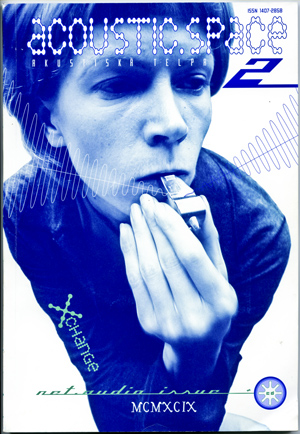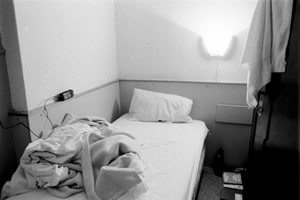Three questions for participants in the Migrating Realities conference, as posed by Vytautas …
VM: If you migrate what really migrates? Geographical migration is so natural to our times that we should look for other definitions of the phenomena of migration. Actually, artists and cultural producers were and are always migrating, so we don’t have any problem in those fields. Can we differentiate between physical migration and migration in the networks?
ME: As I move, anywhere, at all — leaning over from the chair I sit on to look out the window, within the room where I type this text, outside to the market, to the airport and into a plane — my actual point-of-view changes. We are constantly moving and changing our points-of-view. Often we will desire to have the same point-of-view as an Other, or think that an Other should share our point-of-view. Many times we try this because we are afraid to trust our own point-of-view, where we are in that moment. When we step away from our own point-of-view, we lose contact with what is a deep source in life, the process of internal change. And anyway, if we want to take someone else’s point-of-view, we can try, but in the end it is impossible to have their eyes and our eyes at the same point in space and time. Migration is simply another specific word describing the changing that occurs to our of point-of-view as we transit through life.
Often I get the feeling, as I move through the international transportation network that more and more is becoming the same in that system. Maybe this an affect of life exposed to the international standards and protocols that govern such intensive engineering systems. Idiosyncrasy is not so welcome. Change is not welcome. Surprise and difference are not welcome. It is the same in all techno-social infrastructures and systems, including telecommunications networks, that indeterminacy is denied. Difference is discounted. When I sit and watch the screen, my point of view changes very little. What I see changes, but my point of view does not. In the long term, this is is an enormous shift from an embodied life where point-of-view changes constantly. What do we lose when our point-of-view does not change? We interrupt our evolution. Although this interruption is only temporary, as all is change. When our point-of-view is looking at the screen, we are all having, artificially, the same point of view. What is it that we see?
VM: I am actually myself constantly migrating from theory to practice and vice versa. This happens because of my teaching jobs at Vilnius University and Vilnius Academy of Arts. It’s only the third year of this type of migration, so I do not fell any consequences yet. Can you share with some interesting experiences which happens after those kinds of migrations?
ME: For me this is no migration. Nor even a ‘changing of hats.’ As a former engineer coming from a hard science background, now an artist and educator, I came to believe that this kind of migration is simply what people on the outside perceived about me. To the individual, internal life is a continuous phenomena where change (as in migration) is simply another experience of the change (at all temporal and spatial scales) that is the fundamental characteristic of the universe. Again, to emphasize the concept: all is change. The attitude we take when confronting change will govern the quality of life and the possibilities that it presents. A hard resistance to change, and a strict adhering to ‘wearing the proper hat at the proper time’ will limit the possibilities that the unknown and unexpected bring to life. An acceptance of change brings vital energies into every action, every practice that we undertake. These principles apply whether we are migrating from the bedroom to the kitchen, or from Asia to Latin America. From my own experiences, crossing the borders of many nations, many disciplines, and seeking to understand other points-of-view, I find that the possibilities of seeing the world from multiple points-of-view becomes a powerful tool for that understanding. It is a tool whose use cannot be learned except through these experiences, these dislocations. The world as-it-is is deeply connected to the experience of the observer and of the actor in it. We carry the imprint of all our points-of-view with us at all times. When we can bring multiple points-of-view to actions in that world, the actions are by nature more powerful because they are formed from a deeper experience of observing.
I could write many stories, and indeed, have written many stories about this migration in my personal travelog which has now entered its thirteenth year. You are welcome to explore them at https://www.neoscenes.net/travelog/weblog.php
VM: However, sometimes migration is not tolerated. We may take for example: academia and migration between disciplines. The same happens with fine arts (to be more precise, academies and art markets), where migration of ideas between different mediums is hardly possible. I mean that academia and markets prefer some particular art medium to another, limiting the potential fluidity between them. Do we need this kind of migration and where lies the problem within it? Finally, where is interdisciplinarity in this framework?
ME: It seems like a migration, but this situation is embedded in the world-view. A materialist world-view makes distinctions between the appearance of things (and people), and subsequently to the material characteristics of the social system that humans construct. I believe this is a redundant world-view and is in desperate need of being retired! The question of interdisciplinarity is largely framed by this materialist point-of-view. By labeling someone as an artist, a scientist, an educator, a curator, a critic, a researcher, a historian, or any other title, we remove the acknowledgment that the person in question might be as well something else. A fixed and rigid title makes our relation with that person ‘safe’ because these common terms are well-defined and known in a typical social system. We know who they are, and therefore what they do. They are no longer the unknown stranger. But safety and security is an illusion that command-and-control social systems try to fool a population into believing: that change and the unknown are somehow under human control. An open system that allows the Self to confront the unknowns evolving from change has a much higher potential for innovation. Migration across social boundaries is always necessary — just as the wandering Buddhist monk, equipped only with the clothes on his back and a bowl, is the social tool that ‘allows’ the normal population to learn about generosity — so it is with the migrant, the unknown stranger, who can teach the native to overcome a fear of the unknown and open his home to feed and house the traveler and to share stories of the near and of the far.
The problem with this migration is only a problem for those who fear. Although, sometimes, as history often demonstrates, the fear in the native is so great that the stranger is killed before telling his story, before the table is shared and before the bread can be broken. So there is risk to the migrant. That is the only problem. Fear.
Another comment on interdisciplinarity: the one who rides two or three or four tigers is doomed to an exciting life in the wilderness. When he visits the City, he will be feared for the smell he brings, the smell of the unknown. But it is better than trudging along a well-used pathway with the nose in the dirt, following the crowd and fearing.





